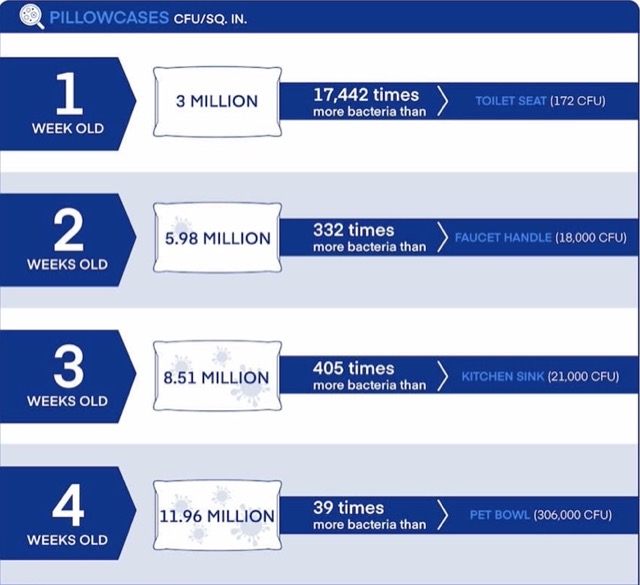According to a report released in mid-June by mattress maker Amerisleep and broadcast by the New York Post : our pillowcase would be a real nest of germs and this, after only a week. The latter would contain an average of 3 million bacteria after 7 days (much more than a toilet seat) and this figure would rise to 11.96 million in 4 weeks (a figure higher than the number of bacteria in a pet’s bowl). )
To get these results, the mattress company researched and used NSF.org data on the matter, as well as that from lab-tested germ samples.
But why is a pillowcase so quickly contaminated with so many bacteria? Dr. Hadley King, explains it to New York Post :
“When you go to bed, you contaminate your bedding with dead skin cells (about 50 million a day), sweat, makeup, lotions, hair, and anything else you picked up during the day. It also includes pollen, pet dander, fungal molds, dirt particles, bacteria, and virus particles.

What to do to fight this proliferation of bacteria?
To combat this proliferation of bacteria unfortunately there is only one thing to do: change out your pillowcase and wash it in the washing machine at 60 degrees so that germs can make their way.
But after how long does it take to renew the bed linen? WELL should be done on average every two days for pillowcases. For sheets and duvet covers, this period can extend to one week. In reality, few people comply with this recommendation due to lack of time, because they don’t have direct access to a washing machine or simply for ecological reasons…
What do you risk when you don’t wash your bedding regularly enough?
On average, 55 percent of single young people (between 18 and 25 years old) wash their bedding only once every 3 months, according to a report from mattress manufacturer Ergoflex. But what exactly are we risking when we don’t put the sheets in the washing machine as often as we should? To begin with, we need to understand that what we reject at night is a real godsend for dust mites, as Dr. King explains: “Dead skin cells and sweat are food for dust mites, they attract them to bed and help them multiply”. Dust mites, and more precisely 8 of them, are the most frequent cause of respiratory allergy and asthma attack. They are even more dangerous than pollen.
But that is not all! Since we lay our face on the same pillowcase every day, we also deposit sebum, dead cells and product residues there. Elements that can, over time, proliferate and therefore create the appearance of imperfections and infections.
And you, how often do you wash your pillowcase?
Do you like our articles? You will love our newsletters! Sign up for free on this page.
Source: Madmoizelle
Mary Crossley is an author at “The Fashion Vibes”. She is a seasoned journalist who is dedicated to delivering the latest news to her readers. With a keen sense of what’s important, Mary covers a wide range of topics, from politics to lifestyle and everything in between.




